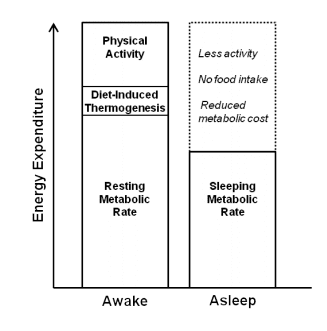Human Energy Expenditure (EE) is not stable over a 24-hour period. It varies depending on the time of day, physical activity, the composition of food intake and the quantity of food. The metabolism of one person is very different from that of another. Besides that, our nutrient utilization at the same energy expenditure levels can differ during the day.
The human 24-hour energy expenditure consists of several components. The components can be identified as different stages of the 24-hour energy expenditure. It is possible to measure the different components of 24-hour energy expenditure by allocating individual components to a timeframe. Despite its complexity, the components of human body 24-h EE can be identified and measured with Indirect Calorimetry (IC) equipment, such as the Room Calorimeter or the Omnical. In this series, we will describe all the EE components.
We will start our series with SMR, i.e., the sleeping metabolic rate.
Understanding Sleep metabolic rate
Researchers and experts differ in their approach of measuring SMR. One approach is to calculate it at the lowest EE measured throughout the night, through three successive hours. Alternatively, the EE during the lowest activity levels (over three consecutive hours) is taken for SMR calculations. The latter approach needs equipment like a motion sensor or an accelerometer that can accurately track human motion and activity indoors. Researchers sometimes use a metabolic cart to measure SMR. However, there is a widespread agreement on the accuracy and control provided by Whole Room Calorimeters (WRC). This advanced instrument includes all technical features needed to measure the subject’s parameters while controlling the environmental factors. If measured accurately, SMR is a repeatable 24-hour EE component with very low daily variations for the subject under study.
Measurement sensitivities of SMR
SMR values can be put off by the Thermal Effect of Food (TEF), especially if measured in the early hours (4 to 6 hours after the last meal) of the night. It can be a confounding variable, as EE usually decreases during sleep. While EE has high levels in early part of the night, it gradually decreases as the night progresses, partially due to the reducing effect of TEF. There is another constraint while calculating SMR – the “first night effect”. The subject can experience prolonged hours of wakefulness on first night, though this anomaly can be largely offset by taking measurements over successive nights.
The RICORS 1.0 (Room Indirect Calorimetry Operating and Reporting Standards) contains more detailed information and procedures for carrying out indirect calorimetry measurements. This article is written by experienced experts and specialists.
Are you planning to measure SMR for your research?
Maastricht Instruments’ goal is to provide researchers and health professionals with the ability to achieve the most accurate and reproducible measurements of human energy metabolism. If you are planning to measure SMR ask about our Omnical indirect calorimetry metabolic cart (ventilated hood, sport and room calorimetry option), whole room calorimeter systems or accelerometry systems. Contact us or find more information on our information pages.
- Chen KY, Smith S, Ravussin E, Krakoff J, Plasqui G, Tanaka S, Murgatroyd P, Brychta R, Bock C, Carnero E, Schoffelen P, Hatamoto Y, Rynders C, Melanson EL. Room Indirect Calorimetry Operating and Reporting Standards (RICORS 1.0): A Guide to Conducting and Reporting Human Whole-Room Calorimeter Studies. Obesity (Silver Spring). 2020 Sep;28(9):1613-1625.
- Alcántara Alcántara, Juan Manuel. Assessment of resting energy expenditure and nutrient oxidation by indirect calorimetry: methodological implications. Granada: Universidad de Granada, 2021.
- Spaeth, Andrea Marie, “Consequences of Chronic Sleep Restriction on Energy Balance in Healthy Adults” (2014)

